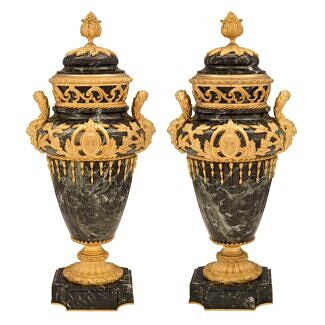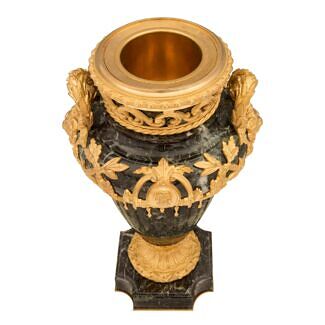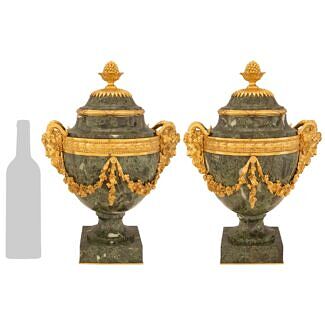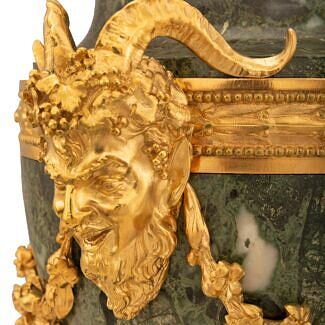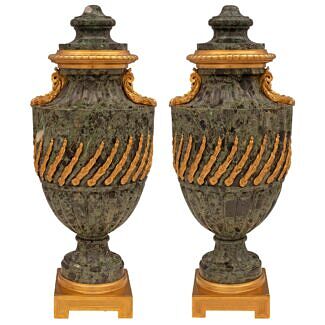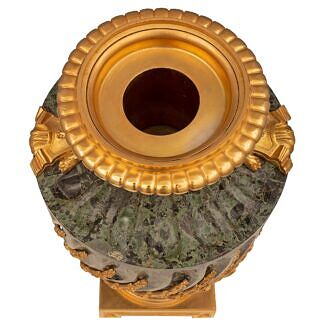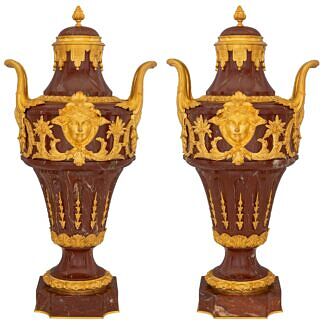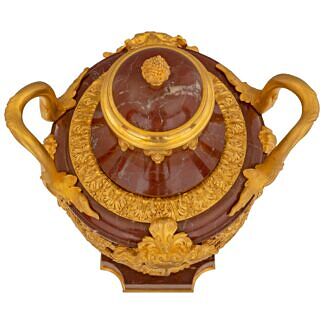A pair of French 19th century Louis XVI st. Belle Époque period Ancient Green marble and Ormolu urns, signed F. Barbedienne
An elegant and high quality pair of French 19th century Louis XVI st. Belle Époque period Ancient Green marble and Ormolu urns, signed F. Barbedienne. Each exquisite urn is raised by a square marble base with a bottom Ormolu plate... — Read More
An elegant and high quality pair of French 19th century Louis XVI st. Belle Époque period Ancient Green marble and Ormolu urns, signed F. Barbedienne. Each exquisite urn is raised by a square marble base with a bottom Ormolu plate and an Ormolu berried wreath band. Above the socle pedestal are finely chased foliate movements and striking Ormolu mounts leading up each side. Two charming young boys are holding draped berried laurel garlands amidst foliate patterns on a rich Vitruvian scrolled background. The mottled removable lids display fabulous top finals and foliate grape clusters above an acanthus leaf band at the rim. The urns and lids are also finished on the inside. All original gilt throughout. — Read Less
- Item # 14135
-
H: 17.5 in L: 8.5 in D: 7.5 in
H: 44 cm L: 22 cm D: 19 cm
- France
- 19th Century
- Marble/Stone, Ormolu
-
Belle Époque Period Read More,
Louis XVI st. Read More
(Belle Époque Period) -
Gaining its name from the optimistic and peaceful period of time between 1871 and World War I, Belle Epoque means “beautiful period”, and occurred during the era of the Third French Republic. This period of economic, colonial, and scientific prosperity brought with it a flourishing artistic climate with numerous literal, musical, theatrical, and visual masterpieces being created.
The Eiffel Tower, which was constructed between 1887 and 1889, served as the entrance to the World’s Fair held in Paris. That same year, the Moulin Rouge cabaret in Paris was founded and showcased the now more mainstream styles of performance including can-can dancing. Belle Epoque dancers and singers were Paris celebrities and became immortalized by the poster arts of Toulouse-Lautrec.
Leading up to this period in 1865, the American Civil War was coming to a close, with France proposing to construct the Statue of Liberty as a joint effort with the United States. France would be responsible for the statue, with America constructing the pedestal. Created to celebrate the nation’s success in building a viable democracy, the statue would stand as a symbol of friendship between the French and American people.
(Louis XVI st.) -
Also known as Louis Seize, Louis XVI's style is a style of architecture, furniture, decoration, and art created during Louis XVI’s 19-year reign in France, just before the French Revolution.
Thought to be a reaction and juxtaposition to the prior more elaborate styles, Louis XVI style developed at the end of the Baroque Period and continued until the birth of French Neoclassicism.
King Louis XVI showed little enthusiasm for the old world styles of the Baroque Period and he sought out a create a new “beau ideal” that focused on the purity and grandeur of Ancient Romans and Greeks.
Inspired by Ancient Roman architecture and art, distinct features of the Louis XVI style are linear lines, small repeated motifs, floral medallions hanging from ribbons, acanthus leaves, urns, dolphins, ram, and lion heads, and griffins.
Greco-Roman elements, often used in earlier and later French styles, were also quick common and included fluted and twisted columns, Caryathids, and corbels.
- Ferdinand Barbedienne Read More
Ferdinand Barbedienne (1810 – 1892), a renowned French Bronzier. Between 1850 and 1854 his firm, Barbedienne, provided furnishings in the Renaissance Revival style for the Hôtel de Ville, Paris. They received numerous medals at the International Exhibitions, including medals in three different classes at the International Exhibition of 1862 in London.
Payment Plan Option Learn More Choose the payment plan option at checkout and customize this payment option with our team. Payment plans are flexible and items will ship once all payments are received.




















